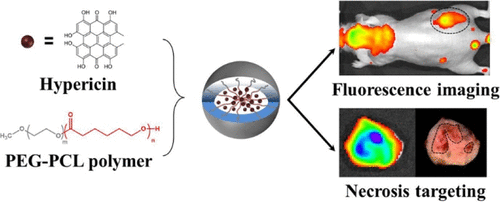当前位置:
X-MOL 学术
›
Mol. Pharmaceutics
›
论文详情
Our official English website, www.x-mol.net, welcomes your
feedback! (Note: you will need to create a separate account there.)
Biodegradable Hypericin-Containing Nanoparticles for Necrosis Targeting and Fluorescence Imaging.
Molecular Pharmaceutics ( IF 4.5 ) Pub Date : 2020-03-26 , DOI: 10.1021/acs.molpharmaceut.9b01238 Xiangjun Han 1 , Olena Taratula 2 , Oleh Taratula 2 , Ke Xu 1 , Anna St Lorenz 2 , Abraham Moses 2 , Younes Jahangiri 3 , Guibo Yu 1 , Khashayar Farsad 3
Molecular Pharmaceutics ( IF 4.5 ) Pub Date : 2020-03-26 , DOI: 10.1021/acs.molpharmaceut.9b01238 Xiangjun Han 1 , Olena Taratula 2 , Oleh Taratula 2 , Ke Xu 1 , Anna St Lorenz 2 , Abraham Moses 2 , Younes Jahangiri 3 , Guibo Yu 1 , Khashayar Farsad 3
Affiliation

|
Necrosis targeting and imaging has significant implications for evaluating tumor growth, therapeutic response, and delivery of therapeutics to perinecrotic tumor zones. Hypericin is a hydrophobic molecule with high necrosis affinity and fluorescence imaging properties. To date, the safe and effective delivery of hypericin to areas of necrosis in vivo remains a challenge because of its incompatible biophysical properties. To address this issue, we have developed a biodegradable nanoparticle (Hyp-NP) for delivery of hypericin to tumors for necrosis targeting and fluorescence imaging. The nanoparticle was developed using methoxy poly(ethylene glycol)-b-poly(ε-caprolactone) and hypericin by a modified solvent evaporation technique. The size of Hyp-NP was 19.0 ± 1.8 nm from cryo-TEM and 37.3 ± 0.7 nm from dynamic light-scattering analysis with a polydispersity index of 0.15 ± 0.01. The encapsulation efficiency of hypericin was 95.05% w/w by UV-vis absorption. After storage for 30 days, 91.4% hypericin was retained in Hyp-NP with nearly no change in hydrodynamic size, representing nanoparticle stability. In an ovarian cancer cell line, Hyp-NP demonstrated cellular internalization with intracellular cytoplasmic localization and preserved fluorescence and necrosis affinity. In a mouse subcutaneous tumor model, tumor accumulation was noted at 8 h postinjection, with near-complete clearance at 96 h postinjection. Hyp-NP was shown to be tightly localized within necrotic tumor zones. Histological analysis of harvested organs demonstrated no gross abnormalities, and in vitro, no hemolysis was observed. This proof-of-concept study demonstrates the potential clinical applications of Hyp-NP for necrosis targeting.
中文翻译:

用于坏死靶向和荧光成像的可生物降解的含有金丝桃素的纳米颗粒。
坏死靶向和成像对评估肿瘤生长,治疗反应以及将治疗药物递送至坏死性肿瘤区具有重要意义。金丝桃素是具有高坏死亲和力和荧光成像特性的疏水分子。迄今为止,由于金丝桃素的生物物理特性不相容,因此安全有效地将金丝桃素递送至体内坏死区域仍然是一个挑战。为了解决这个问题,我们开发了一种可生物降解的纳米颗粒(Hyp-NP),用于将金丝桃素递送至肿瘤,用于靶向坏死和荧光成像。通过改进的溶剂蒸发技术,使用甲氧基聚(乙二醇)-b-聚(ε-己内酯)和金丝桃素开发纳米颗粒。Hyp-NP的大小从cryo-TEM到19.0±1.8 nm,从37.3±0开始。来自动态光散射分析的7 nm,多分散指数为0.15±0.01。通过紫外可见吸收,金丝桃素的包封效率为95.05%w / w。储存30天后,Hyp-NP中保留了91.4%的金丝桃素,流体动力学尺寸几乎没有变化,代表了纳米粒子的稳定性。在卵巢癌细胞系中,Hyp-NP表现出具有细胞内细胞质定位的细胞内化作用,并保留了荧光和坏死亲和力。在小鼠皮下肿瘤模型中,在注射后8 h观察到肿瘤积累,在注射后96 h清除接近完全。已显示Hyp-NP紧密位于坏死肿瘤区域内。采集器官的组织学分析表明未见明显异常,在体外未观察到溶血现象。
更新日期:2020-03-26
中文翻译:

用于坏死靶向和荧光成像的可生物降解的含有金丝桃素的纳米颗粒。
坏死靶向和成像对评估肿瘤生长,治疗反应以及将治疗药物递送至坏死性肿瘤区具有重要意义。金丝桃素是具有高坏死亲和力和荧光成像特性的疏水分子。迄今为止,由于金丝桃素的生物物理特性不相容,因此安全有效地将金丝桃素递送至体内坏死区域仍然是一个挑战。为了解决这个问题,我们开发了一种可生物降解的纳米颗粒(Hyp-NP),用于将金丝桃素递送至肿瘤,用于靶向坏死和荧光成像。通过改进的溶剂蒸发技术,使用甲氧基聚(乙二醇)-b-聚(ε-己内酯)和金丝桃素开发纳米颗粒。Hyp-NP的大小从cryo-TEM到19.0±1.8 nm,从37.3±0开始。来自动态光散射分析的7 nm,多分散指数为0.15±0.01。通过紫外可见吸收,金丝桃素的包封效率为95.05%w / w。储存30天后,Hyp-NP中保留了91.4%的金丝桃素,流体动力学尺寸几乎没有变化,代表了纳米粒子的稳定性。在卵巢癌细胞系中,Hyp-NP表现出具有细胞内细胞质定位的细胞内化作用,并保留了荧光和坏死亲和力。在小鼠皮下肿瘤模型中,在注射后8 h观察到肿瘤积累,在注射后96 h清除接近完全。已显示Hyp-NP紧密位于坏死肿瘤区域内。采集器官的组织学分析表明未见明显异常,在体外未观察到溶血现象。











































 京公网安备 11010802027423号
京公网安备 11010802027423号